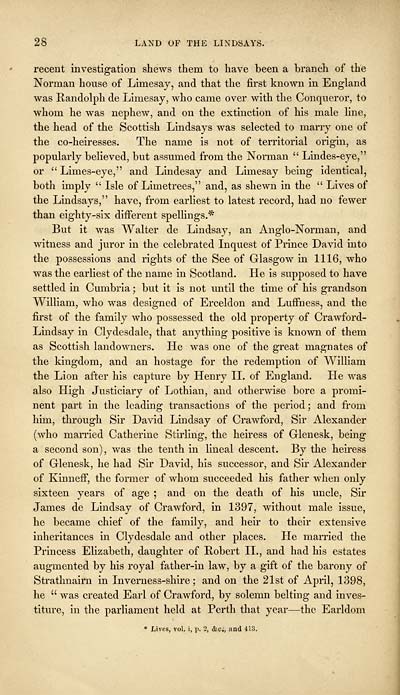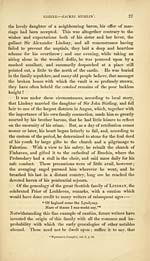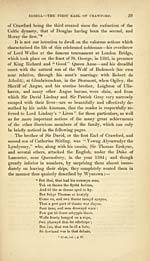Download files
Complete book:
Individual page:
Thumbnail gallery: Grid view | List view

28 LAND OF THE LINDSAYS.
recent investigation shews them to have been a branch of the
Norman house of Limesay, and that the first known in England
was Randolph de Limesay, who came over with the Conqueror, to
whom he was nephew, and on the extinction of his male line,
the head of the Scottish Lindsays was selected to many one of
the co-heiresses. The name is not of territorial origin, as
popularly believed, but assumed from the Norman " Lindes-eye,"
or " Limes-eye," and Lindesay and Limesay being identical,
both imply " Isle of Limetrees," and, as shewn in the " Lives of
the Lindsays," have, from earliest to latest record, had no fewer
than eighty-six different spellings.*
But it was Walter de Lindsay, an Anglo-Norman, and
witness and juror in the celebrated Inquest of Prince David into
the possessions and rights of the See of Glasgow in 1116, who
was the earliest of the name in Scotland. He is supposed to have
settled in Cumbria ; but it is not until the time of his grandson
William, who was designed of Erceldon and Luffness, and the
first of the family who possessed the old property of Crawford-
Lindsay in Clydesdale, that anything positive is known of them
as Scottish landowners. He was one of the great magnates of
the kingdom, and an hostage for the redemption of William
the Lion after his capture by Henry II. of England. He was
also High Justiciary of Lothian, and otherwise bore a promi-
nent part in the leading transactions of the period ; and from
him, through Sir David Lindsay of Crawford, Sir Alexander
(who married Catherine Stirling, the heiress of Glenesk, being
a second son), was the tenth in lineal descent. By the heiress
of Glenesk, he had Sir David, his successor, and Sir Alexander
of Kinneff, the former of whom succeeded his father when only
sixteen years of age ; and on the death of his uncle, Sir
James de Lindsay of Crawford, in 1397, without male issue,
he became chief of the family, and heir to their extensive
inheritances in Clydesdale and other places. He married the
Princess Elizabeth, daughter of Robert II., and had his estates
augmented by his royal father-in law, by a gift of the barony of
Strathnairn in Inverness-shire ; and on the 21st of April, 1398,
he " was created Earl of Crawford, by solemn belting and inves-
titure, in the parliament held at Perth that year — the Earldom
* Lives, vol. i, p. 2, &ci, and 413.
recent investigation shews them to have been a branch of the
Norman house of Limesay, and that the first known in England
was Randolph de Limesay, who came over with the Conqueror, to
whom he was nephew, and on the extinction of his male line,
the head of the Scottish Lindsays was selected to many one of
the co-heiresses. The name is not of territorial origin, as
popularly believed, but assumed from the Norman " Lindes-eye,"
or " Limes-eye," and Lindesay and Limesay being identical,
both imply " Isle of Limetrees," and, as shewn in the " Lives of
the Lindsays," have, from earliest to latest record, had no fewer
than eighty-six different spellings.*
But it was Walter de Lindsay, an Anglo-Norman, and
witness and juror in the celebrated Inquest of Prince David into
the possessions and rights of the See of Glasgow in 1116, who
was the earliest of the name in Scotland. He is supposed to have
settled in Cumbria ; but it is not until the time of his grandson
William, who was designed of Erceldon and Luffness, and the
first of the family who possessed the old property of Crawford-
Lindsay in Clydesdale, that anything positive is known of them
as Scottish landowners. He was one of the great magnates of
the kingdom, and an hostage for the redemption of William
the Lion after his capture by Henry II. of England. He was
also High Justiciary of Lothian, and otherwise bore a promi-
nent part in the leading transactions of the period ; and from
him, through Sir David Lindsay of Crawford, Sir Alexander
(who married Catherine Stirling, the heiress of Glenesk, being
a second son), was the tenth in lineal descent. By the heiress
of Glenesk, he had Sir David, his successor, and Sir Alexander
of Kinneff, the former of whom succeeded his father when only
sixteen years of age ; and on the death of his uncle, Sir
James de Lindsay of Crawford, in 1397, without male issue,
he became chief of the family, and heir to their extensive
inheritances in Clydesdale and other places. He married the
Princess Elizabeth, daughter of Robert II., and had his estates
augmented by his royal father-in law, by a gift of the barony of
Strathnairn in Inverness-shire ; and on the 21st of April, 1398,
he " was created Earl of Crawford, by solemn belting and inves-
titure, in the parliament held at Perth that year — the Earldom
* Lives, vol. i, p. 2, &ci, and 413.
Set display mode to:
![]() Universal Viewer |
Universal Viewer | ![]() Mirador |
Large image | Transcription
Mirador |
Large image | Transcription
Images and transcriptions on this page, including medium image downloads, may be used under the Creative Commons Attribution 4.0 International Licence unless otherwise stated. ![]()
| Histories of Scottish families > History and traditions of the land of the Lindsays in Angus and Mearns > (46) Page 28 |
|---|
| Permanent URL | https://digital.nls.uk/94869578 |
|---|
| Description | A selection of almost 400 printed items relating to the history of Scottish families, mostly dating from the 19th and early 20th centuries. Includes memoirs, genealogies and clan histories, with a few produced by emigrant families. The earliest family history goes back to AD 916. |
|---|

